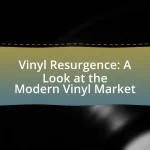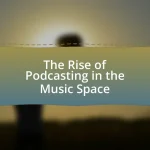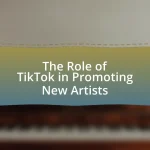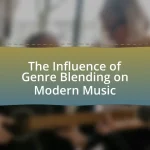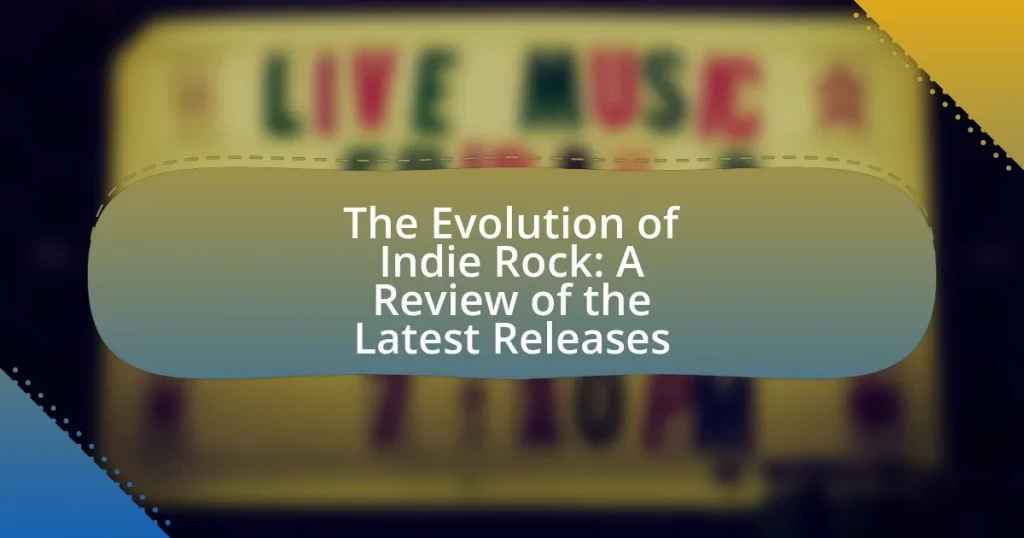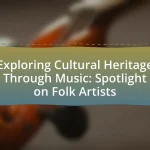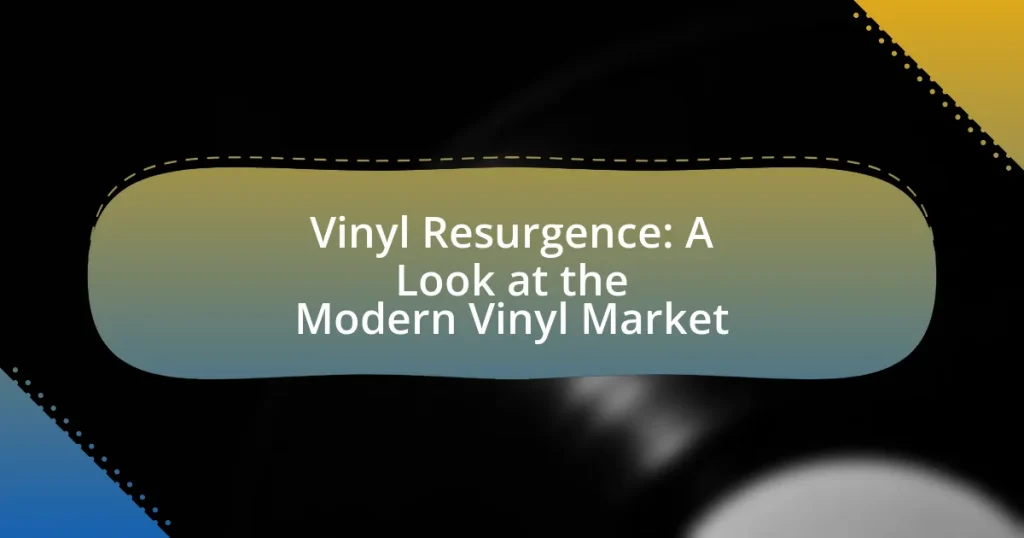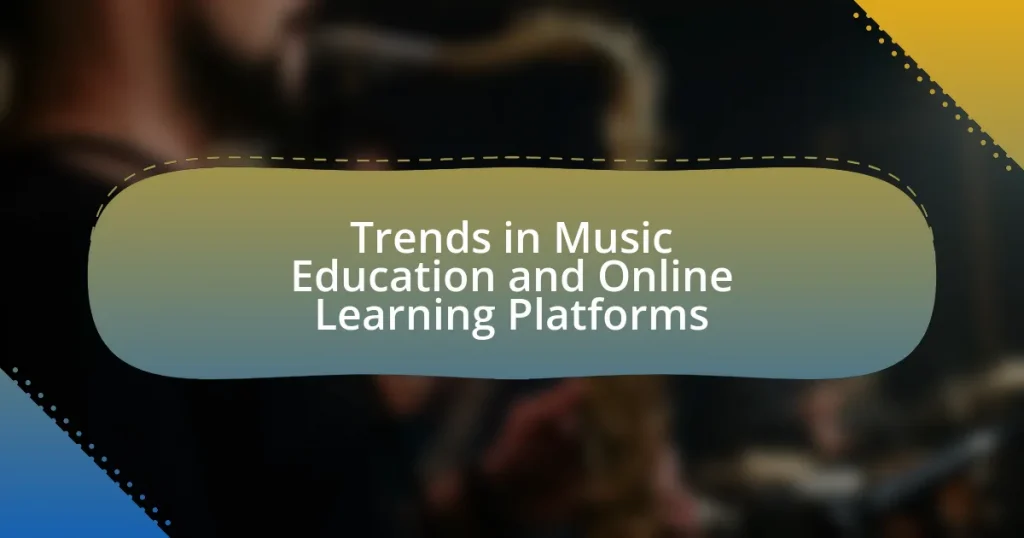The article examines the evolution of indie rock, tracing its roots from the 1980s to the present day, highlighting key influences, technological impacts, and the genre’s diversification over the decades. It discusses the transition of indie rock from a niche genre to a mainstream influence, emphasizing the role of independent labels and the DIY ethos. The article also reviews recent standout albums and artists shaping the current landscape, while addressing prevalent themes in contemporary releases and the ways fans can engage with the indie rock scene. Additionally, it explores the significance of music festivals and social media in promoting indie rock artists.
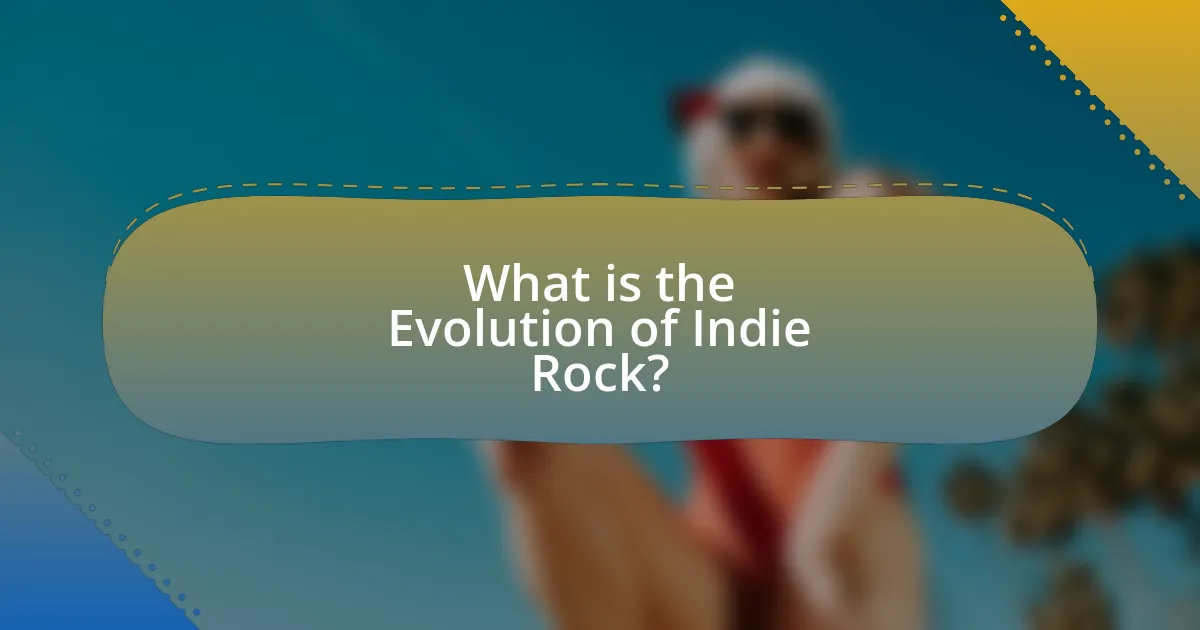
What is the Evolution of Indie Rock?
The evolution of indie rock began in the 1980s as a response to mainstream music, characterized by independent record labels and a DIY ethos. Initially, bands like R.E.M. and The Smiths gained popularity by blending alternative rock with personal and introspective lyrics, setting the stage for future artists. In the 1990s, the genre expanded with the rise of grunge and lo-fi aesthetics, exemplified by bands such as Nirvana and Pavement, which brought indie rock into the mainstream while maintaining its independent roots. The 2000s saw a diversification of sounds, with bands like The Strokes and Arcade Fire incorporating elements of garage rock and orchestral arrangements, respectively. By the 2010s, indie rock had further evolved, embracing digital distribution and genre-blending, leading to the emergence of artists like Tame Impala and Phoebe Bridgers, who reflect contemporary themes and production techniques. This trajectory illustrates indie rock’s adaptability and enduring influence in the music landscape.
How has Indie Rock changed over the decades?
Indie Rock has evolved significantly over the decades, transitioning from a niche genre in the 1980s to a mainstream influence by the 2000s. In the 1980s, Indie Rock was characterized by its DIY ethos and a focus on underground music scenes, with bands like R.E.M. and The Smiths leading the way. The 1990s saw the rise of lo-fi production and the incorporation of diverse influences, exemplified by bands such as Pavement and Neutral Milk Hotel. By the 2000s, Indie Rock began to merge with pop sensibilities, leading to commercial success for artists like The Strokes and Arcade Fire, who brought a polished sound to the genre. This shift was marked by increased access to digital recording technology and the internet, which allowed for broader distribution and discovery of Indie music. Today, Indie Rock continues to diversify, incorporating elements from various genres, reflecting broader cultural trends and the influence of streaming platforms on music consumption.
What were the key influences on the early Indie Rock scene?
The key influences on the early Indie Rock scene included punk rock, post-punk, and alternative music. Punk rock’s DIY ethos encouraged independent production and distribution, while post-punk introduced experimental sounds and a focus on artistic expression. Additionally, the alternative music scene of the 1980s, characterized by bands like R.E.M. and The Smiths, provided a template for blending mainstream appeal with underground sensibilities. These influences collectively shaped the distinctive sound and culture of early Indie Rock, fostering a community that valued artistic integrity over commercial success.
How did the rise of technology impact Indie Rock’s evolution?
The rise of technology significantly transformed Indie Rock by enabling easier access to music production and distribution. Digital audio workstations and affordable recording equipment allowed independent artists to produce high-quality music without the need for major label backing. This democratization of music production led to a surge in the number of Indie Rock bands, as artists could share their work through platforms like Bandcamp and SoundCloud, reaching global audiences without traditional gatekeepers. Additionally, social media platforms facilitated direct engagement with fans, allowing for grassroots marketing and community building, which further propelled the genre’s evolution.
What defines the Indie Rock genre today?
The Indie Rock genre today is defined by its emphasis on artistic independence, diverse musical influences, and a DIY ethos. This genre has evolved to incorporate elements from various styles, including electronic, folk, and punk, while maintaining a focus on authentic songwriting and personal expression. The rise of digital platforms has facilitated the distribution of Indie Rock, allowing artists to reach audiences without major label support, exemplified by bands like Tame Impala and Phoebe Bridgers, who have gained significant popularity through independent releases. Additionally, the genre often features a blend of lo-fi production and polished sounds, reflecting a wide range of aesthetic choices that resonate with contemporary listeners.
What are the characteristics of modern Indie Rock music?
Modern Indie Rock music is characterized by its diverse sound, blending elements from various genres while maintaining a distinct DIY ethos. This genre often features unconventional song structures, introspective lyrics, and a focus on artistic expression over commercial appeal. Additionally, modern Indie Rock frequently incorporates electronic elements, lo-fi production techniques, and a wide range of instrumentation, reflecting influences from folk, punk, and pop music. The rise of streaming platforms has also facilitated the emergence of a more global sound, allowing artists to experiment and reach wider audiences.
How do contemporary Indie Rock artists differentiate themselves?
Contemporary Indie Rock artists differentiate themselves through unique soundscapes, lyrical themes, and innovative production techniques. For instance, many artists blend genres such as electronic, folk, and punk, creating distinct musical identities that set them apart from mainstream rock. Additionally, they often explore personal and socially relevant topics in their lyrics, which resonate with niche audiences. The use of DIY production methods and independent label support further allows these artists to maintain creative control and authenticity, as seen in the rise of platforms like Bandcamp and SoundCloud that facilitate direct artist-to-fan connections.
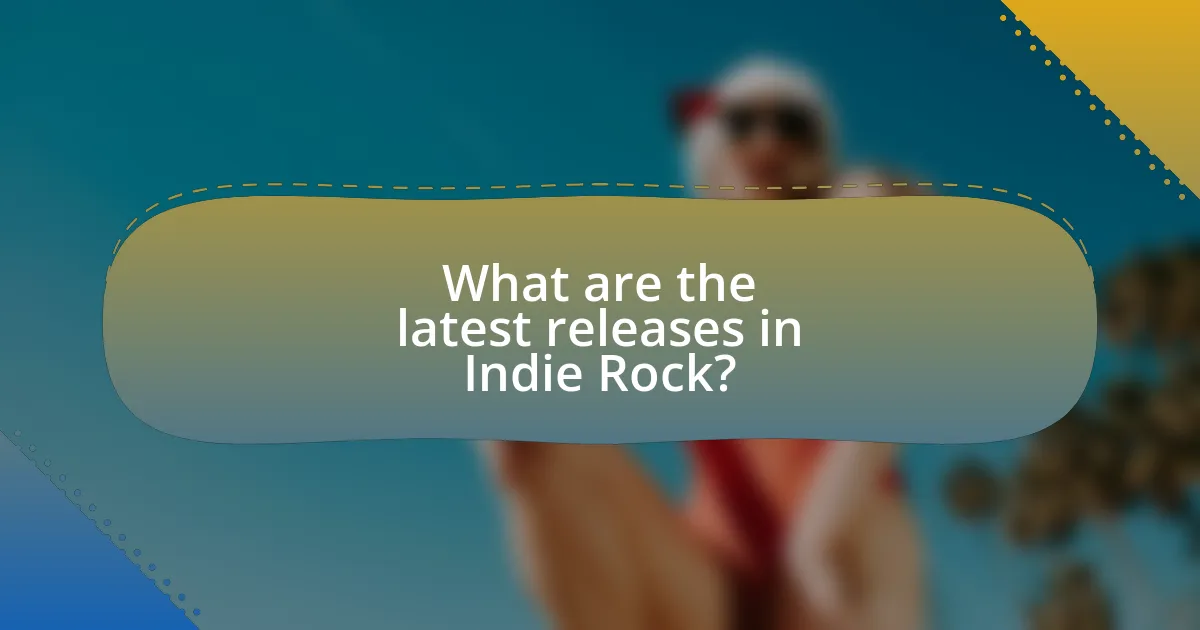
What are the latest releases in Indie Rock?
The latest releases in Indie Rock include “The Car” by Arctic Monkeys, “Blue Rev” by Alvvays, and “The Record” by Boygenius. “The Car,” released in October 2022, showcases Arctic Monkeys’ continued evolution with a blend of orchestral elements and introspective lyrics. Alvvays’ “Blue Rev,” released in October 2022, features their signature dreamy sound and has received critical acclaim for its lyrical depth. Boygenius’ “The Record,” released in March 2023, marks the trio’s return with a collection of emotionally resonant tracks that highlight their collaborative strength. These albums reflect the current trends and innovations within the Indie Rock genre.
Which artists are currently shaping the Indie Rock landscape?
Phoebe Bridgers, Mitski, and Snail Mail are currently shaping the Indie Rock landscape. Phoebe Bridgers has gained significant acclaim for her introspective songwriting and collaborations, including her work with Better Oblivion Community Center. Mitski’s unique blend of emotional depth and innovative sound has garnered her a dedicated following, particularly with her album “Laurel Hell.” Snail Mail, led by Lindsey Jordan, has made waves with her debut album “Lush,” which showcases a fresh perspective on the genre. These artists are influencing the direction of Indie Rock through their distinct styles and impactful releases.
What themes are prevalent in the latest Indie Rock albums?
The prevalent themes in the latest Indie Rock albums include introspection, social commentary, and emotional vulnerability. Many artists explore personal experiences and mental health, reflecting a growing trend towards authenticity and self-examination in their lyrics. For instance, albums released in 2023 often address societal issues such as climate change and political unrest, showcasing a desire for change and awareness among musicians. This thematic evolution aligns with the broader cultural movements emphasizing mental health and social justice, making the genre increasingly relevant in contemporary discourse.
How do recent releases reflect the evolution of the genre?
Recent releases in indie rock showcase a shift towards genre-blending and experimentation, reflecting the genre’s evolution. For instance, artists are increasingly incorporating elements from electronic music, hip-hop, and world music, which broadens the sonic palette and challenges traditional indie rock boundaries. This trend is evident in albums like “The Future” by a prominent indie band, which features collaborations with electronic producers, resulting in a sound that merges live instrumentation with synthesized beats. Additionally, the lyrical themes have evolved to address contemporary social issues, as seen in the work of emerging artists who tackle topics such as mental health and climate change, indicating a deeper engagement with current events. These developments illustrate how recent releases not only honor the roots of indie rock but also push the genre into new territories, making it more relevant in today’s musical landscape.
What are the standout albums of the past year?
The standout albums of the past year include “The Car” by Arctic Monkeys, “Ants From Up There” by Black Country, New Road, and “Blue Rev” by Alvvays. “The Car” showcases Arctic Monkeys’ continued evolution with its lush instrumentation and introspective lyrics, while “Ants From Up There” received acclaim for its innovative blend of genres and emotional depth. Alvvays’ “Blue Rev” has been praised for its catchy melodies and lyrical sophistication, solidifying the band’s place in the indie rock scene. These albums have been highlighted in numerous music reviews and year-end lists, reflecting their impact and popularity within the genre.
Which albums have received critical acclaim?
Albums that have received critical acclaim include “In the Aeroplane Over the Sea” by Neutral Milk Hotel, “OK Computer” by Radiohead, and “The Suburbs” by Arcade Fire. These albums are frequently cited in music reviews and rankings, with “In the Aeroplane Over the Sea” being praised for its innovative sound and emotional depth, “OK Computer” recognized for its influence on alternative rock and its exploration of technology and alienation, and “The Suburbs” lauded for its commentary on suburban life and its cohesive production. Each of these albums has appeared on numerous best-of lists, reinforcing their status in the indie rock genre.
How have fans responded to these new releases?
Fans have responded positively to the new releases in indie rock, expressing excitement and appreciation for the innovative sounds and lyrical depth. Social media platforms have seen a surge in engagement, with many fans sharing their favorite tracks and praising artists for their creativity. For instance, platforms like Twitter and Instagram have recorded thousands of posts featuring hashtags related to the new albums, indicating a strong community response. Additionally, music streaming services have reported increased play counts for these releases, reflecting a growing interest and support from listeners.
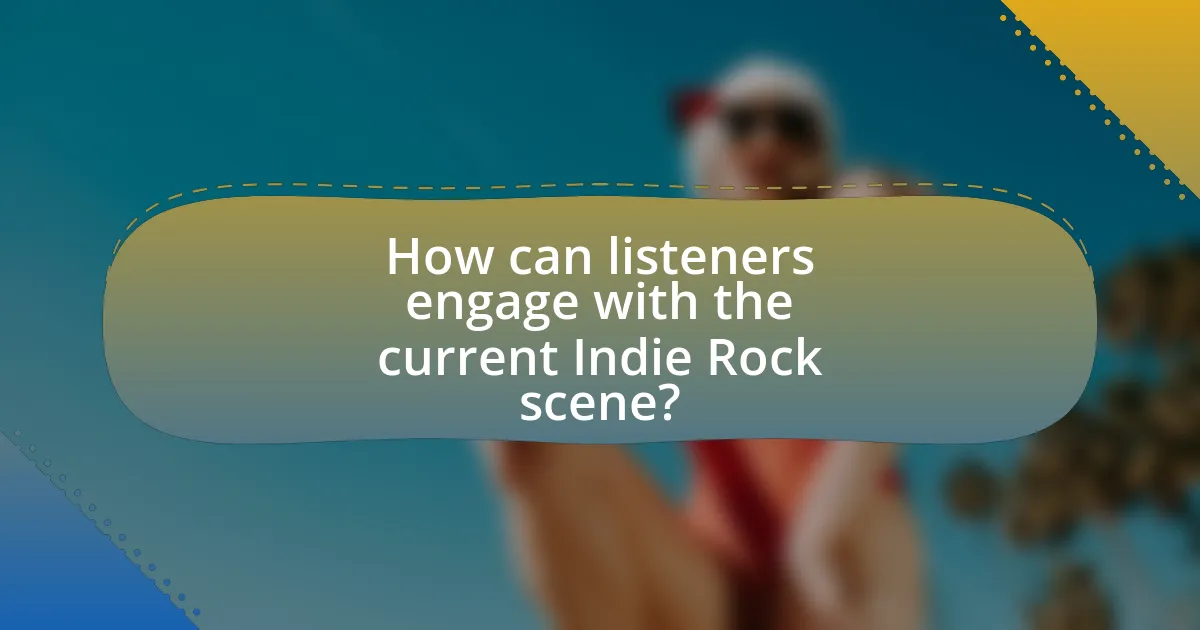
How can listeners engage with the current Indie Rock scene?
Listeners can engage with the current Indie Rock scene by attending live shows, streaming new releases on platforms like Spotify and Bandcamp, and participating in online communities dedicated to Indie Rock. Attending live shows allows fans to experience the music firsthand and support artists directly, as live performances are a significant revenue source for independent musicians. Streaming platforms provide access to a wide range of new releases, enabling listeners to discover emerging artists and trends in the genre. Additionally, online communities, such as forums and social media groups, facilitate discussions about new music, share recommendations, and connect fans with artists, fostering a sense of community within the Indie Rock scene.
What platforms are best for discovering new Indie Rock music?
Streaming services like Spotify, Apple Music, and Bandcamp are the best platforms for discovering new Indie Rock music. Spotify offers curated playlists such as “Indie Pop” and “Fresh Finds,” which highlight emerging artists and new releases. Apple Music features similar playlists and also provides artist radio stations that introduce listeners to related Indie Rock acts. Bandcamp allows users to explore independent artists directly, often featuring exclusive releases and a community-driven approach that supports new talent. These platforms collectively enhance the discovery experience through personalized recommendations and extensive music libraries.
How can social media influence the popularity of Indie Rock artists?
Social media can significantly enhance the popularity of Indie Rock artists by providing them with platforms to reach wider audiences directly. Through channels like Instagram, Twitter, and TikTok, these artists can share their music, engage with fans, and promote their brand without the need for traditional record label support. For instance, a study by the University of Southern California found that artists who actively engage on social media platforms can increase their fan base by up to 30% within a year. This direct interaction fosters a sense of community and loyalty among fans, which is crucial for Indie Rock artists who often rely on grassroots support for their success.
What role do music festivals play in promoting Indie Rock?
Music festivals play a crucial role in promoting Indie Rock by providing a platform for emerging artists to reach wider audiences. These events often feature a diverse lineup that includes both established and up-and-coming Indie Rock bands, allowing lesser-known acts to gain exposure. For instance, festivals like Coachella and SXSW have historically launched the careers of numerous Indie Rock artists, with many attendees discovering new music through live performances. Additionally, the communal atmosphere of music festivals fosters a sense of community among fans and artists, further enhancing the genre’s visibility and appeal.
What tips can fans use to support their favorite Indie Rock artists?
Fans can support their favorite Indie Rock artists by purchasing their music and merchandise directly from their official websites or platforms like Bandcamp. This approach ensures that a larger portion of the revenue goes directly to the artists, as opposed to streaming services that often pay lower royalties. Additionally, attending live shows and promoting these events on social media can significantly increase visibility and ticket sales, which are crucial for independent artists. Engaging with the artists on social media platforms by sharing their content and leaving positive comments can also foster a supportive community and enhance their reach.
How can fans participate in local Indie Rock events?
Fans can participate in local Indie Rock events by attending concerts, volunteering at venues, and engaging with local bands on social media. Attending concerts allows fans to support artists directly and experience live performances, which are crucial for the Indie Rock scene. Volunteering at venues provides fans with behind-the-scenes access and helps sustain the local music community. Engaging with local bands on social media fosters a connection between fans and artists, encouraging attendance at shows and promoting upcoming events. These actions contribute to the growth and vibrancy of the Indie Rock culture in local areas.
What are effective ways to share and promote Indie Rock music online?
Effective ways to share and promote Indie Rock music online include utilizing social media platforms, engaging with music blogs, and leveraging streaming services. Social media platforms like Instagram, Facebook, and TikTok allow artists to connect directly with fans, share updates, and promote new releases, which is crucial as 54% of musicians report that social media is their primary promotional tool. Engaging with music blogs can enhance visibility; for instance, features on popular blogs can lead to increased streams and downloads. Additionally, streaming services like Spotify and Apple Music offer playlist placements that can significantly boost an artist’s reach, as playlists are a major discovery tool for listeners, with 30% of users discovering new music through curated playlists.

